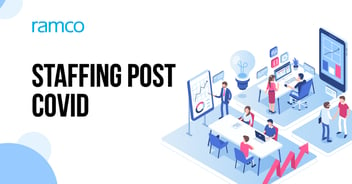

The arrival of Covid-19 accelerated already existing trends that we all were seeing in much of our daily lives. Certainly, the most dramatic change has been in the domain of work. The era of digitization was already upon us when Covid-19 struck, speeding up certain trends that have altered our relationships with work, the workplace, and work-colleagues. Remote or hybrid offices have changed the dynamics for organizations and their employees, changing the complex variety and depth of interactions employees have with each other, within an organization’s workforce network.
The implications of these changes are many and companies must be aware of them if they do not want to amplify the negative impacts towards employee productivity and morale.
Managing the digital workplace effectively
A large number of employees working from home and not coming to the office means that the workplace is not a physical space anymore but a digital network of relationships and interactions between interconnected employees, using digital communication tools like MS teams, Zoom and others, to get work done.
Working in digital spaces creates challenges in productivity for the organisation. Fostering collaboration between employees in the digital space can be more difficult. 43% of leaders say that relationship building is the greatest challenge in remote and hybrid work. This can be especially true with new hires who may only get to know and interact with other team members through a ZOOM or MS Teams screen. Information sharing can also become difficult and cumbersome. A simple set of instructions, or a query that could have taken moments to resolve if the required person was next to you, may in fact take much longer than expected, leading to delays and productivity loss.
To discourage this productivity loss, organisations need to develop digital practices to build social connections within the team to facilitate working together. In this context, ERP solutions can play a crucial role by integrating various digital tools and processes, enhancing overall collaboration and efficiency.
There also needs to be management support for flexibility and experimentation: empowering employees and teams to find and adopt new and better solutions. Working in a digital environment means thinking about new ways to resolve productivity problems and coming up with digital solutions that many teams may not be aware of. ERP services can help organizations streamline these processes and improve their adaptability to new digital tools and work structures.
Therefore, coming up with new tools, or work structures may be required. And this is what organisations (and especially managers) must allow and encourage to foster within teams.
Focus on Employee health and Wellness
There are also employee health and management-employee relationship implications due to changes in workforce dynamics. The need of the hour is to pivot health support towards limiting the negative effects of a sedentary lifestyle that has increased considerably with employees working from home. One of the key lessons from the pandemic is that organisations need to empower their employees with data and knowledge about their own health. A survey by Nasscom shows that the average time spent per week on MS Teams increased by 252% for the average employee. It may come as no surprise therefore that in the same survey, 53% employees said they were more likely to prioritize their health and well being over work than before the pandemic.
Employees must have an understanding as well as access to ways they can help themselves on their mental and physical wellbeing. Companies empowering their employees in this way help in unleashing their employees on a journey of improved personal wellbeing, thereby seeing benefits in productivity in the organization overall.
Focus on developing a new set of skills
Today, on the technological aspect, every facet of the work environment is experiencing significant change. The implications of these changes on the workforce are very consequential. The biggest challenge is the skilling aspect. i.e., ways organisations need to adapt themselves to new technologies and at the same time, speedily train their workforce to effectively use those technologies. All organisations, employers, and employees must accept the new digital reality that digital technologies are evolving very quickly and that stakeholders must be ready to continuously experiment with new tools, management techniques and organizational structures to remain competitive. ERP solutions are integral to managing these technological shifts and ensuring that the workforce is equipped with the necessary skills.
According to a Mckinsey report, the trend in demand is for employees with high cognitive, technological, as well as stronger social and emotional skills. Organisations and higher management must pivot their learning & development programs towards these skillsets.
Managing an ever-increasing number of contract workers
Gig jobs, also known as temporary or contract jobs, are expected to outnumber traditional nine-to-five, office-based jobs. In India, for example, the share of contract workforce as total labour force is expected to become larger than the permanent workforce as early as 2027. In today’s digital era the traditional definition of the gig or contract job has changed. In addition to the traditional delivery partners and ridesharing taxi drivers there are now teachers and tutors, software developers, consultants and writers, bookkeepers and accountants, and many other roles that can be considered part of the gig economy. Organisations are finding that utilizing contract workers can be beneficial, and so are expanding their use of such a workforce. Currently, However, gig workers are not as broadly covered as permanent hires in terms of various social security benefits. The legal and regulatory environment is slowly moving forward to take steps to formalize gig and contract workers.
But there is more that employers can do already. Some steps that they can take is to provide opportunities and incentives for skill upgradation which presently, gig workers have to do at their own cost. Then there is the provision of various extra benefits such as social security, maternity benefits, accident and health insurance etc.
The overall point is that prudently managing contract employees is becoming more important as companies across industries hire contract employees in greater numbers. A work environment in which the interests of contract employees are protected and respected, is an environment where employees can deliver their best output.
The new era of work is upon us, and it is a vastly different one than pre-2020. For organisations and their management, overcoming the challenges of a digital work environment means using new approaches to generate employee engagement. ERP services can assist in this transformation by providing comprehensive solutions that support effective management of digital workspace. Organisation leadership must bring out empathy and compassion to their management style through digital means, and change their focus from the traditional managing efficiency to managing towards outcome, giving more autonomy to workers on how they get their assignments and tasks completed.
Doing so will bring out the most engagement and productivity in today’s digital workplace.
Related Posts


